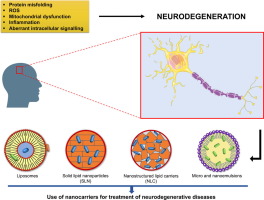当前位置:
X-MOL 学术
›
Eur. J. Pharm. Biopharm.
›
论文详情
Our official English website, www.x-mol.net, welcomes your feedback! (Note: you will need to create a separate account there.)
Current insights on lipid nanocarrier-assisted drug delivery in the treatment of neurodegenerative diseases.
European Journal of Pharmaceutics and Biopharmaceutics ( IF 4.9 ) Pub Date : 2020-01-23 , DOI: 10.1016/j.ejpb.2020.01.005 M I Teixeira 1 , C M Lopes 2 , M H Amaral 1 , P C Costa 1
European Journal of Pharmaceutics and Biopharmaceutics ( IF 4.9 ) Pub Date : 2020-01-23 , DOI: 10.1016/j.ejpb.2020.01.005 M I Teixeira 1 , C M Lopes 2 , M H Amaral 1 , P C Costa 1
Affiliation

|
The central nervous system (CNS) is vulnerable to pathologic processes that lead to the development of neurodegenerative disorders like Alzheimer's, Parkinson's and Huntington's diseases, Multiple sclerosis or Amyotrophic lateral sclerosis. These are chronic and progressive pathologies characterized by the loss of neurons and the formation of misfolded proteins. Additionally, neurodegenerative diseases are accompanied by a structural and functional dysfunction of the blood-brain barrier (BBB). Although serving as a protection for CNS, the existence of physiological barriers, especially the BBB, limits the access of several therapeutic agents to the brain, constituting a major hindrance in neurotherapeutics advancement. In this regard, nanotechnology-based approaches have arisen as a promising strategy to not only improve drug targeting to the brain, but also to increase bioavailability. Lipid nanocarriers such as liposomes, solid lipid nanoparticles (SLN), nanostructured lipid carriers (NLC), microemulsions and nanoemulsions, have already proven their potential for enhancing brain transport, crossing more easily into the CNS and allowing the administration of medicines that could benefit the treatment of neurological pathologies. Given the socioeconomic impact of such conditions and the advent of nanotechnology that inevitably leads to more effective and superior therapeutics for their management, it is imperative to constantly update on the current knowledge of these topics. Herein, we provide insight on the BBB and the pathophysiology of the main neurodegenerative disorders. Moreover, this review seeks to highlight the several approaches that can be used to improve the delivery of therapeutic agents to the CNS, while also offering an extensive overview of the latest efforts regarding the use of lipid-based nanocarriers in the management of neurodegenerative diseases.
中文翻译:

脂质纳米载体辅助药物在神经退行性疾病治疗中的最新见解。
中枢神经系统(CNS)易受导致神经退行性疾病如阿尔茨海默氏症,帕金森氏症和亨廷顿氏症,多发性硬化症或肌萎缩性侧索硬化症的发展的病理过程的影响。这些是慢性和进行性病理,其特征在于神经元的丢失和错误折叠的蛋白质的形成。另外,神经退行性疾病伴有血脑屏障(BBB)的结构和功能障碍。尽管可以作为中枢神经系统的保护物,但生理屏障(尤其是血脑屏障)的存在限制了几种治疗剂进入大脑的能力,这构成了神经治疗学发展的主要障碍。在这方面,基于纳米技术的方法已成为一种有前途的策略,不仅可以改善针对大脑的药物靶向性,而且可以提高生物利用度。脂质纳米载体,例如脂质体,固体脂质纳米颗粒(SLN),纳米结构脂质载体(NLC),微乳剂和纳米乳剂,已经证明它们具有增强脑运输,更容易进入中枢神经系统并允许给药对人体有益的药物的潜力。神经病理学的治疗。考虑到这种情况的社会经济影响以及纳米技术的出现不可避免地导致对其进行管理的更有效和更好的治疗方法,必须不断更新有关这些主题的最新知识。在这里,我们提供有关血脑屏障和主要神经退行性疾病的病理生理学的见解。
更新日期:2020-01-23
中文翻译:

脂质纳米载体辅助药物在神经退行性疾病治疗中的最新见解。
中枢神经系统(CNS)易受导致神经退行性疾病如阿尔茨海默氏症,帕金森氏症和亨廷顿氏症,多发性硬化症或肌萎缩性侧索硬化症的发展的病理过程的影响。这些是慢性和进行性病理,其特征在于神经元的丢失和错误折叠的蛋白质的形成。另外,神经退行性疾病伴有血脑屏障(BBB)的结构和功能障碍。尽管可以作为中枢神经系统的保护物,但生理屏障(尤其是血脑屏障)的存在限制了几种治疗剂进入大脑的能力,这构成了神经治疗学发展的主要障碍。在这方面,基于纳米技术的方法已成为一种有前途的策略,不仅可以改善针对大脑的药物靶向性,而且可以提高生物利用度。脂质纳米载体,例如脂质体,固体脂质纳米颗粒(SLN),纳米结构脂质载体(NLC),微乳剂和纳米乳剂,已经证明它们具有增强脑运输,更容易进入中枢神经系统并允许给药对人体有益的药物的潜力。神经病理学的治疗。考虑到这种情况的社会经济影响以及纳米技术的出现不可避免地导致对其进行管理的更有效和更好的治疗方法,必须不断更新有关这些主题的最新知识。在这里,我们提供有关血脑屏障和主要神经退行性疾病的病理生理学的见解。


























 京公网安备 11010802027423号
京公网安备 11010802027423号